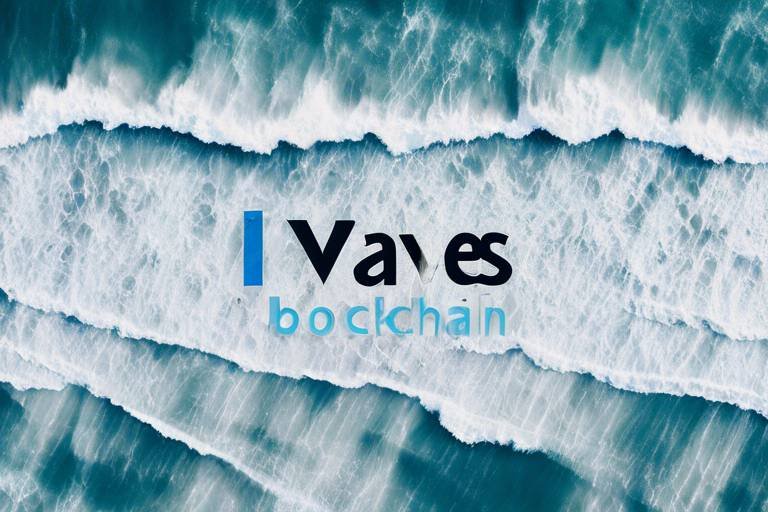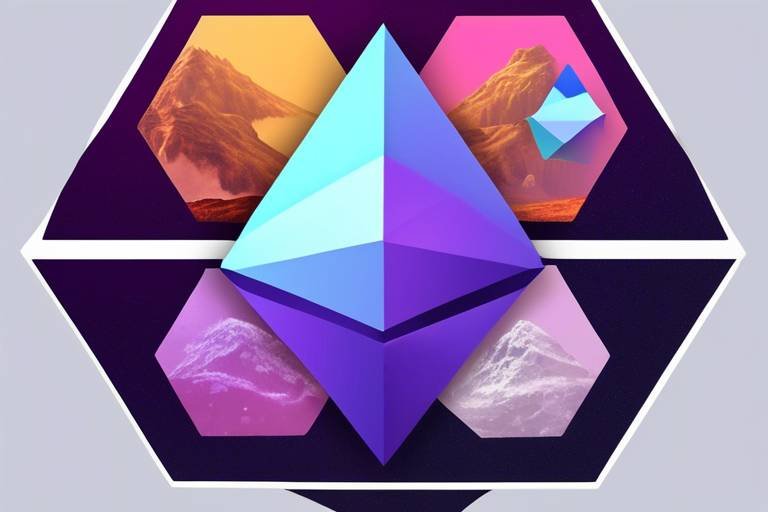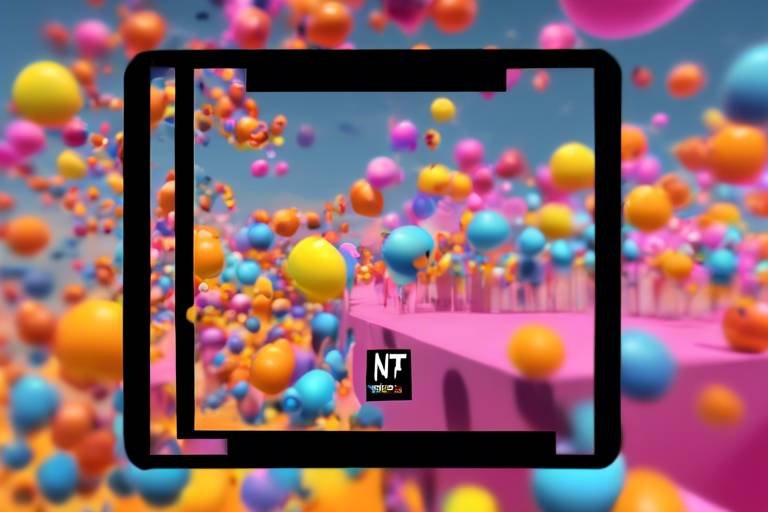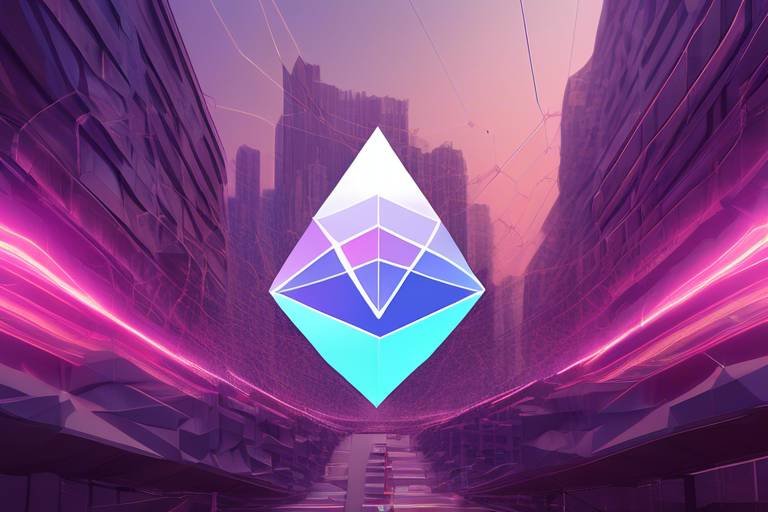Solana - Speed and Scalability in a Growing Ecosystem
In the ever-evolving world of blockchain technology, Solana has emerged as a powerhouse, captivating developers and users alike with its remarkable speed and scalability. But what makes Solana stand out in a crowded field of blockchain platforms? This article takes a deep dive into Solana's innovative technology, dissecting its architecture, performance metrics, and the real-world applications that have contributed to its meteoric rise in the blockchain space.
Imagine a bustling highway during rush hour. Now, envision a road that can accommodate thousands of cars without a hint of congestion. That's the essence of Solana—an infrastructure designed to handle a massive influx of transactions without compromising speed. With its unique architecture, Solana is not just another blockchain; it's a revolution in how we perceive transaction throughput and efficiency.
At the heart of Solana's design lies its groundbreaking Proof of History (PoH) consensus mechanism, which acts like a timekeeper, recording the order of events and ensuring that every transaction is verified in a lightning-fast manner. This innovative approach is a game-changer, allowing Solana to achieve transaction speeds that are often compared to traditional payment systems, yet with the security that blockchain technology promises.
As we explore further, it's essential to understand the performance metrics that set Solana apart from its competitors. With the ability to process over 65,000 transactions per second, Solana not only rivals but often surpasses the capabilities of established platforms like Ethereum. This efficiency translates into lower transaction costs, making it an attractive option for developers and users alike. For instance, the average transaction fee on Solana can be as low as $0.00025, a stark contrast to Ethereum's fluctuating fees that can soar during peak times.
But speed alone doesn't tell the whole story. Solana's ecosystem is rapidly expanding, with a diverse range of applications emerging across various sectors, including decentralized finance (DeFi), non-fungible tokens (NFTs), and gaming. Each of these use cases showcases Solana's versatility and its potential to redefine how we interact with digital assets. For instance, in the DeFi space, Solana's low transaction costs and high throughput are transforming traditional financial systems, making them more accessible to a broader audience.
As we delve deeper into Solana's role in the DeFi landscape, it's fascinating to see how it has attracted a plethora of innovative projects. Developers are flocking to Solana, eager to leverage its capabilities to create solutions that push the boundaries of what's possible in finance. From lending platforms to automated market makers, the possibilities are endless.
However, it's essential to approach any technology with a balanced perspective. While Solana's advantages are clear, it does face challenges. Issues such as network outages, security concerns, and fierce competition from other blockchains are factors that could impact its growth trajectory. As the blockchain space continues to evolve, Solana must navigate these challenges while maintaining the speed and scalability that have become its hallmark.
In conclusion, Solana's innovative architecture, impressive performance metrics, and real-world applications position it as a leader in the blockchain ecosystem. As we continue to witness its growth, one thing is certain: Solana is not just a fleeting trend; it's a fundamental shift in how we think about speed and scalability in the digital age.
- What is Solana's Proof of History?
Proof of History is a consensus mechanism that timestamps transactions to ensure their order and verify the integrity of the blockchain. - How fast can Solana process transactions?
Solana can handle over 65,000 transactions per second, making it one of the fastest blockchains available. - What are some popular projects on Solana?
Solana hosts a variety of projects, especially in the DeFi and NFT spaces, including platforms like Serum and Solanart. - What challenges does Solana face?
Some challenges include network outages, potential security vulnerabilities, and competition from other blockchain platforms.
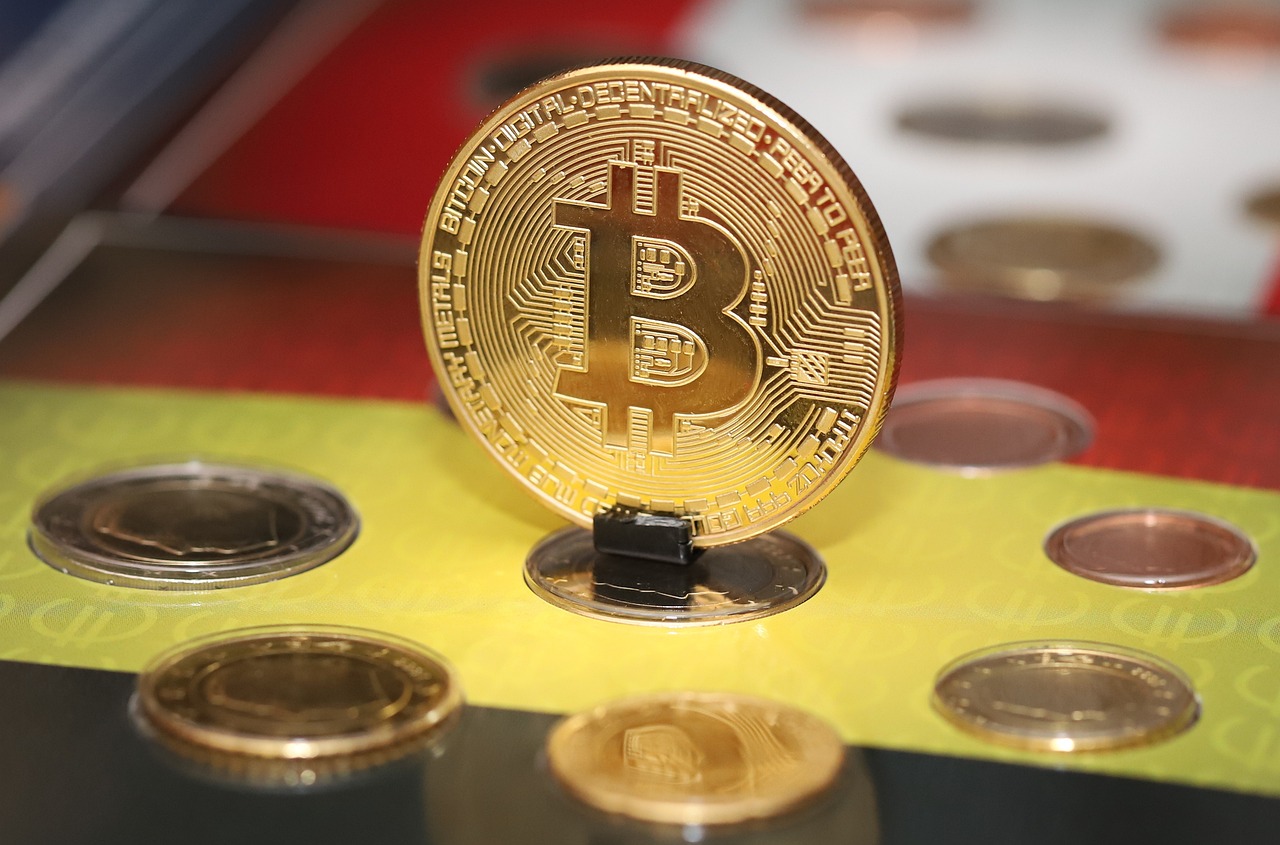
Understanding Solana's Architecture
When it comes to blockchain technology, having a robust and efficient architecture is crucial. Solana's architecture is a breath of fresh air in a crowded space, designed specifically for high throughput and low latency. At the heart of its system lies a unique combination of innovative technologies that set it apart from traditional blockchains. One of the standout features of Solana is its Proof of History (PoH) consensus mechanism, which not only enhances speed but also ensures the security and integrity of transactions.
This mechanism works like a time-stamping service, creating a historical record that proves that an event has occurred at a specific moment in time. Imagine it as a digital clock that everyone in the network agrees upon, providing a reliable timeline for transactions. This is a game changer because it allows nodes to process transactions more efficiently without having to communicate back and forth to verify the order of events, which is a common bottleneck in other blockchains.
Solana's architecture can be broken down into several key components:
- Proof of History (PoH): As mentioned, this mechanism provides a verifiable order of events, allowing for rapid transaction processing.
- Tower BFT: This is Solana's version of a Byzantine Fault Tolerance algorithm that helps achieve consensus quickly while maintaining security.
- Gulf Stream: This is a mempool-less transaction forwarding protocol that enables transactions to be sent directly to the validators, significantly reducing confirmation times.
- Sealevel: Solana's parallel smart contract runtime allows for concurrent execution of transactions, maximizing throughput.
These components work together harmoniously to create a blockchain that can handle thousands of transactions per second, making it one of the fastest platforms available today. To give you a clearer picture, let's take a look at a comparative table that highlights Solana's architecture alongside traditional blockchain systems:
| Feature | Solana | Traditional Blockchains (e.g., Ethereum) |
|---|---|---|
| Consensus Mechanism | Proof of History | Proof of Work / Proof of Stake |
| Transaction Speed | Up to 65,000 TPS | 15-30 TPS |
| Transaction Costs | Fraction of a cent | Varies, often higher |
| Smart Contract Execution | Parallel Execution (Sealevel) | Sequential Execution |
In summary, Solana's architecture is not just about speed; it's about creating a scalable and efficient environment for developers and users alike. By leveraging innovative technologies like Proof of History and Tower BFT, Solana is paving the way for a blockchain ecosystem that can support the demands of modern applications, from decentralized finance to gaming and beyond.

Performance Metrics of Solana
When it comes to blockchain technology, performance is everything. Solana has been making waves in the crypto space, and its performance metrics are a big part of the conversation. Imagine a highway where cars zoom by at lightning speed—this is essentially what Solana offers to its users. With the ability to handle thousands of transactions per second (TPS), Solana is not just fast; it’s a game changer. To put this into perspective, let’s dive into some key metrics that highlight Solana’s impressive capabilities.
One of the standout features of Solana is its transaction speed. On average, transactions on Solana can be confirmed in just a matter of seconds—often around 400 milliseconds. This rapid confirmation time is crucial for applications that require real-time processing, such as trading platforms and gaming applications. In comparison, Ethereum, one of the leading blockchains, can take anywhere from 15 seconds to several minutes for transaction confirmations. This stark difference positions Solana as a frontrunner in the race for speed.
In addition to speed, transaction costs play a vital role in the overall performance of a blockchain. Solana boasts transaction fees that average around $0.00025 per transaction. Yes, you read that right—just a fraction of a cent! This low-cost structure makes it incredibly appealing for developers and users alike, especially when compared to Ethereum, where fees can skyrocket to several dollars during peak times. With Solana, users can perform microtransactions without worrying about exorbitant fees eating into their profits.
To give you a clearer picture of how Solana stacks up against other blockchains, here’s a quick comparison of some key performance metrics:
| Blockchain | Transactions Per Second (TPS) | Average Transaction Confirmation Time | Average Transaction Cost |
|---|---|---|---|
| Solana | 65,000+ | 400 ms | $0.00025 |
| Ethereum | 30+ | 15-60 seconds | $5+ |
| Bitcoin | 7 | 10-30 minutes | $1+ |
This table illustrates how Solana’s performance metrics surpass those of other popular blockchain platforms, making it an attractive option for developers looking to build scalable applications. But it’s not just about raw numbers; it’s about what those numbers mean for the end-user experience. Faster transactions and lower fees translate into a smoother, more efficient interaction with the blockchain, whether you’re trading, gaming, or using decentralized applications (dApps).
Moreover, Solana’s architecture contributes to its high throughput and efficiency. By utilizing a unique consensus mechanism known as Proof of History (PoH), Solana can verify the order of transactions without requiring all nodes to communicate extensively. This innovation reduces latency and increases overall network efficiency, allowing for a seamless user experience that many other blockchains struggle to achieve.
As we delve deeper into Solana's performance metrics, it's clear that this blockchain is not just a passing trend; it’s a robust platform that is paving the way for the future of decentralized applications. With its exceptional speed, low costs, and innovative technology, Solana is setting a new standard in the blockchain space. So, whether you’re a developer, an investor, or just a curious observer, keeping an eye on Solana is definitely worth your time.
- What is Solana? Solana is a high-performance blockchain platform designed for decentralized applications and crypto projects.
- How fast are transactions on Solana? Transactions on Solana can be confirmed in around 400 milliseconds.
- What are the transaction costs on Solana? The average transaction cost on Solana is approximately $0.00025.
- How does Solana compare to Ethereum? Solana offers significantly higher transaction speeds and lower fees compared to Ethereum.

Transaction Speed and Efficiency
When it comes to blockchain technology, transaction speed and efficiency are the cornerstones that determine a platform's usability and appeal. Solana stands out in this regard, boasting a remarkable ability to process thousands of transactions per second (TPS). But how does it achieve such astounding performance? The secret lies in its innovative architecture and cutting-edge technologies.
At the heart of Solana's speed is its Proof of History (PoH) consensus mechanism. Unlike traditional blockchains that rely on time-stamping transactions, PoH creates a historical record that proves that an event has occurred at a specific moment in time. This unique approach allows Solana to order transactions efficiently, eliminating the need for extensive communication between nodes. As a result, transactions are not only confirmed quickly but also at a fraction of the cost compared to other platforms.
To give you a clearer picture, let’s compare Solana’s transaction speed with that of some other popular blockchains:
| Blockchain | Transactions Per Second (TPS) | Average Transaction Cost |
|---|---|---|
| Solana | Up to 65,000 | $0.00025 |
| Ethereum | 30 | $2.00 (varies widely) |
| Bitcoin | 7 | $0.50 (average) |
As you can see, Solana's capacity to handle an immense number of transactions while keeping costs incredibly low is a game changer. Imagine trying to send money across the globe; would you rather wait for hours and pay hefty fees, or have it done in seconds for mere cents? This is the efficiency that Solana brings to the table, making it an attractive option for developers and users alike.
Furthermore, Solana's architecture allows for parallel processing of transactions, which means that multiple transactions can be executed simultaneously rather than sequentially. This is akin to having multiple lanes on a highway, allowing traffic to flow smoothly without bottlenecks. This parallelization significantly enhances the network's overall throughput, contributing to its reputation as one of the fastest blockchains available.
In conclusion, Solana's transaction speed and efficiency not only set it apart from its competitors but also pave the way for a new era of blockchain applications. Whether you're interested in decentralized finance, NFTs, or gaming, the rapid transaction capabilities of Solana ensure that users experience seamless interactions without the frustrating delays often associated with other platforms.
- What is the maximum transaction speed of Solana? Solana can handle up to 65,000 transactions per second, making it one of the fastest blockchains available.
- How does Solana keep transaction costs low? Solana's unique architecture and the Proof of History consensus mechanism contribute to its low transaction fees, averaging around $0.00025 per transaction.
- What makes Solana different from Ethereum? While Ethereum processes around 30 transactions per second, Solana's ability to handle thousands of transactions simultaneously gives it a significant advantage in speed and efficiency.

Proof of History Explained
At the heart of Solana's incredible speed and efficiency lies a groundbreaking concept known as Proof of History (PoH). But what exactly is PoH, and why is it such a game-changer in the blockchain world? Imagine trying to organize a party where everyone shows up at different times, and you have to keep track of who arrived when. It can get chaotic, right? Now, envision having a reliable timestamp for each guest as they arrive, allowing you to know the exact order in which people entered. This is similar to how PoH operates, providing a verifiable timeline of events that enhances the overall transaction process.
Proof of History is not just a fancy term; it's a cryptographic clock that allows nodes in the network to agree on the order of transactions without needing to communicate with each other constantly. This reduces the time spent on generating consensus, which is often a bottleneck in traditional blockchain systems. By creating a historical record that proves that an event has occurred at a specific moment, PoH enables Solana to process transactions much more rapidly than its competitors.
To give you a clearer picture, let's break down the key features of Proof of History:
- Timestamping: Each transaction is assigned a unique timestamp, which is crucial for establishing the sequence of events.
- Verifiable Order: PoH provides a way to prove that a specific transaction occurred before another, ensuring that all nodes can trust the order without needing to communicate back and forth.
- Efficiency: By reducing the need for constant communication, PoH allows Solana to achieve thousands of transactions per second, making it one of the fastest blockchains available.
In essence, Proof of History acts as a backbone for Solana's architecture. It streamlines the process of reaching consensus among nodes, which is a critical component for any blockchain's functionality. This innovation not only enhances transaction speeds but also significantly lowers costs, making Solana an attractive option for developers and users alike.
Moreover, the integration of PoH with other technologies, such as Proof of Stake (PoS), creates a robust ecosystem that can handle a vast number of transactions while maintaining security and decentralization. The combination ensures that even as the network grows, it remains efficient and reliable.
In summary, Proof of History is a pivotal element that sets Solana apart in the crowded blockchain space. Its ability to provide a clear, verifiable order of transactions is akin to having a well-organized guest list for that party we mentioned earlier. Everyone knows when they arrived, and there’s no confusion about who came first. This clarity not only facilitates faster transactions but also builds trust within the network, paving the way for a more scalable future.
What is Proof of History?
Proof of History is a cryptographic method used by Solana to create a verifiable order of transactions, enabling faster processing and reducing the need for constant communication between nodes.
How does Proof of History improve transaction speed?
By providing a reliable timestamp for each transaction, PoH allows nodes to quickly agree on the order of events, significantly speeding up the consensus process.
Is Proof of History secure?
Yes, PoH enhances security by ensuring that all transactions are recorded in a verifiable manner, which helps prevent fraud and maintains the integrity of the blockchain.
Can other blockchains implement Proof of History?
While PoH is a unique feature of Solana, the concept of using timestamps and verifiable order could potentially be adapted by other blockchains seeking to improve their transaction speeds and efficiency.

Comparative Analysis with Other Blockchains
When it comes to blockchain technology, comparison is key to understanding the strengths and weaknesses of each platform. Solana has emerged as a formidable player in the blockchain space, but how does it stack up against giants like Ethereum and Binance Smart Chain? To put it simply, Solana’s architecture is tailored for speed and scalability, which sets it apart from many of its competitors.
One of the most significant differences lies in the transaction speed. Solana can process over 65,000 transactions per second (TPS), a staggering figure compared to Ethereum's current capability of around 30 TPS. This difference is crucial for applications requiring high throughput, such as decentralized finance (DeFi) and gaming. Imagine trying to fill a stadium with fans, and you have two entrances: one that lets in 30 people at a time and another that lets in 65,000. Clearly, the latter is going to get the crowd in faster!
In addition to speed, transaction costs are another area where Solana shines. The average transaction fee on Solana is less than $0.01, making it incredibly affordable for users. In contrast, Ethereum has faced scrutiny for its high gas fees, which can soar to several dollars during peak times. This discrepancy makes Solana an attractive option for developers looking to create cost-effective applications.
To illustrate the differences in performance, let's take a look at the following table that summarizes key metrics of Solana compared to Ethereum and Binance Smart Chain:
| Blockchain | Transactions Per Second (TPS) | Average Transaction Fee | Consensus Mechanism |
|---|---|---|---|
| Solana | 65,000+ | <$0.01 | Proof of History |
| Ethereum | 30 | $1-$50 (varies) | Proof of Work (transitioning to Proof of Stake) |
| Binance Smart Chain | 100 | $0.10-$0.50 | Proof of Staked Authority |
While Solana's performance metrics are impressive, it’s essential to consider the trade-offs. For instance, Ethereum has a more extensive ecosystem with established projects and a larger developer community. This maturity can provide a sense of security for users and developers alike, whereas Solana is still in its growth phase, attracting new projects and users daily.
Moreover, Solana's unique Proof of History (PoH) mechanism, while innovative, raises questions about centralization. Some critics argue that the network's speed could lead to fewer validators, potentially compromising decentralization in the long run. On the other hand, Ethereum's transition to Proof of Stake aims to enhance scalability while maintaining decentralization, which could be a critical factor in its ongoing relevance.
In conclusion, while Solana offers remarkable speed and low transaction costs, its long-term success will depend on how well it can navigate challenges such as network stability, security, and competition. As the blockchain landscape continues to evolve, Solana will need to find ways to maintain its edge while fostering a robust community and ecosystem.
- What is Solana? Solana is a high-performance blockchain designed for speed and scalability, capable of processing thousands of transactions per second.
- How does Solana achieve such high transaction speeds? Solana uses a unique Proof of History consensus mechanism that timestamps transactions, allowing for rapid confirmations.
- What are the main use cases for Solana? Solana is used in various applications, including decentralized finance (DeFi), non-fungible tokens (NFTs), and gaming.
- How does Solana compare to Ethereum? Solana has significantly higher transaction speeds and lower fees compared to Ethereum, but Ethereum has a more established ecosystem.

Real-World Use Cases
Solana's impressive speed and scalability have made it a magnet for innovative projects across various sectors. As the blockchain landscape evolves, Solana has emerged as a powerhouse for real-world applications, attracting developers and businesses eager to harness its capabilities. One of the most exciting areas where Solana shines is in **decentralized finance (DeFi)**. With its low transaction costs and lightning-fast confirmation times, DeFi projects on Solana are revolutionizing how we think about lending, borrowing, and trading assets.
In addition to DeFi, the **non-fungible token (NFT)** market has found a robust platform in Solana. Creators and artists are flocking to Solana to mint and sell their digital art, collectibles, and more, thanks to the platform's ability to handle high volumes of transactions without breaking a sweat. This has opened up new opportunities for artists to reach global audiences while keeping costs low. Imagine being able to sell your digital artwork for a fraction of the fees associated with other blockchains!
Another exciting use case is in the realm of **gaming**. Game developers are leveraging Solana's speed to create immersive experiences that require real-time interactions. With the capability to process thousands of transactions per second, players can engage in seamless gameplay, trade in-game assets, and participate in tournaments without the lag that often plagues other platforms. The combination of blockchain technology with gaming on Solana is paving the way for a new era of interactive entertainment.
To illustrate the diversity of projects on Solana, consider the following table showcasing some notable real-world use cases:
| Use Case | Description | Key Features |
|---|---|---|
| Decentralized Finance (DeFi) | Platforms for lending, borrowing, and trading. | Low fees, high transaction speed, and security. |
| Non-Fungible Tokens (NFTs) | Marketplace for digital art and collectibles. | Fast minting, low transaction costs, and wide accessibility. |
| Gaming | Real-time gaming experiences with blockchain integration. | Seamless gameplay, in-game asset trading, and competitive features. |
These examples illustrate just how versatile the Solana blockchain can be. Whether it's enabling a new financial system through DeFi, empowering creators in the NFT space, or enhancing gaming experiences, Solana is not just a platform but a **launchpad for innovation**. As more developers recognize the potential of Solana, we can expect to see even more groundbreaking applications emerge, further solidifying its position in the blockchain ecosystem.
Q1: What makes Solana different from other blockchains?
A1: Solana's unique architecture, which includes the Proof of History consensus mechanism, allows it to achieve high throughput and low latency, setting it apart from many other blockchain platforms.
Q2: Can I use Solana for NFT transactions?
A2: Absolutely! Solana is a popular choice for NFT transactions due to its low fees and fast transaction speeds, making it an attractive platform for artists and collectors alike.
Q3: What are the main challenges facing Solana?
A3: While Solana offers impressive capabilities, it faces challenges such as network outages, potential security concerns, and competition from other blockchain platforms.

The Role of Solana in DeFi
In the dynamic world of decentralized finance (DeFi), Solana has emerged as a game-changer, revolutionizing how we perceive and interact with financial services. Its impressive speed and low transaction costs are not just marketing buzzwords; they represent a fundamental shift in the DeFi landscape. Imagine a world where you can trade, lend, and borrow assets without the usual delays and high fees associated with traditional financial systems. That’s exactly what Solana offers, and it’s drawing in developers and users alike like moths to a flame.
Solana's architecture allows it to process transactions at lightning speed, often achieving thousands of transactions per second. This capability is crucial for DeFi applications that require quick confirmations to facilitate trading and lending. For instance, in a volatile market, the ability to execute trades rapidly can mean the difference between profit and loss. Solana's low fees further enhance its appeal, making it accessible for users who might otherwise shy away from DeFi due to high costs.
One of the most significant impacts of Solana's performance is the way it has attracted various DeFi projects. Developers are flocking to the platform to build innovative solutions that leverage its speed and scalability. Some of the standout projects include:
- Serum: A decentralized exchange (DEX) that offers high-speed trading and low fees, enabling users to trade various assets seamlessly.
- Raydium: A liquidity provider that integrates with Serum, allowing users to earn yield on their assets while maintaining quick access to trades.
- Marinade Finance: A liquid staking protocol that allows users to stake their SOL tokens while still being able to utilize them in DeFi applications.
These projects are just the tip of the iceberg. The Solana ecosystem is rapidly expanding, with new applications and services continuously emerging. This growth can be attributed to the platform's ability to handle high volumes of transactions without compromising performance. As more users and developers engage with Solana, it creates a network effect that further solidifies its position in the DeFi space.
However, it’s essential to recognize that with great power comes great responsibility. While Solana's speed and efficiency are impressive, they also bring challenges. For instance, the rapid growth can lead to network congestion during peak times, raising concerns about stability and reliability. Additionally, as the DeFi space becomes increasingly competitive, Solana must continue innovating to stay ahead of potential rivals.
In conclusion, Solana is carving out a significant role in the DeFi ecosystem. Its combination of speed, low costs, and a growing array of applications makes it a compelling choice for users and developers alike. As the DeFi landscape continues to evolve, Solana's ability to adapt and innovate will be crucial in determining its long-term success.
1. What makes Solana different from other blockchain platforms in DeFi?
Solana's unique architecture, including its Proof of History mechanism, allows it to process transactions much faster and at lower costs compared to traditional blockchains like Ethereum.
2. How can I get started with DeFi on Solana?
To get started, you can create a wallet that supports Solana, purchase SOL tokens, and explore various DeFi applications like Serum or Raydium to begin trading or providing liquidity.
3. Are there any risks associated with using Solana in DeFi?
Like any investment, there are risks involved. Network congestion, potential security vulnerabilities, and the volatile nature of cryptocurrencies are factors to consider when engaging with DeFi on Solana.

Key DeFi Projects on Solana
Solana has quickly become a hotbed for decentralized finance (DeFi) projects, attracting a diverse array of developers and users. The platform's unique combination of speed, scalability, and low transaction costs creates an ideal environment for innovation. Let's take a closer look at some of the standout DeFi projects that are making waves within the Solana ecosystem.
One of the most notable projects is Raydium, an automated market maker (AMM) that integrates with Serum, a decentralized exchange (DEX) on Solana. Raydium allows users to provide liquidity and earn yield while facilitating fast trades with minimal slippage. Its unique liquidity pools leverage Serum's order book, providing users with access to a wider range of trading options and deeper liquidity.
Another exciting project is Marinade Finance, a liquid staking protocol that enables users to stake their SOL tokens while still retaining the ability to use them in other DeFi applications. This dual functionality not only enhances liquidity but also allows users to earn staking rewards without sacrificing the flexibility of their assets. Marinade's innovative approach has garnered significant attention and participation from the community.
Solend is also worth mentioning as a leading lending and borrowing platform on Solana. It allows users to lend their assets for interest or borrow against their holdings with low fees and fast processing times. Solend’s user-friendly interface and efficient smart contracts make it an attractive choice for both seasoned DeFi users and newcomers alike.
Furthermore, Phantom, a wallet designed for the Solana blockchain, plays a crucial role in the DeFi landscape. It provides users with a seamless experience for managing their assets, participating in DeFi protocols, and even interacting with NFTs. Phantom’s intuitive design and robust security features have made it a go-to wallet for many in the Solana community.
As the Solana ecosystem continues to grow, we can expect to see even more innovative DeFi projects emerge. The combination of high throughput and low costs is a game-changer, allowing developers to build solutions that were previously unattainable on other blockchains. With projects like Raydium, Marinade Finance, and Solend leading the charge, Solana is poised to redefine the DeFi landscape.
In conclusion, the DeFi projects on Solana not only showcase the platform's technological advantages but also highlight the creativity and ambition of the developers building on it. As more projects launch and existing ones evolve, Solana's role in the DeFi space will undoubtedly expand, offering users unprecedented opportunities for financial innovation.
- What is Solana? Solana is a high-performance blockchain platform known for its speed and scalability, designed to support decentralized applications and crypto projects.
- What are the advantages of using DeFi projects on Solana? The main advantages include low transaction costs, high throughput, and fast transaction speeds, which enhance the overall user experience.
- Are there risks associated with DeFi projects on Solana? Yes, while DeFi offers many benefits, risks include potential smart contract vulnerabilities, network outages, and market volatility.
- How can I start using DeFi projects on Solana? To get started, you'll need a Solana wallet, such as Phantom, and some SOL tokens to interact with various DeFi protocols.
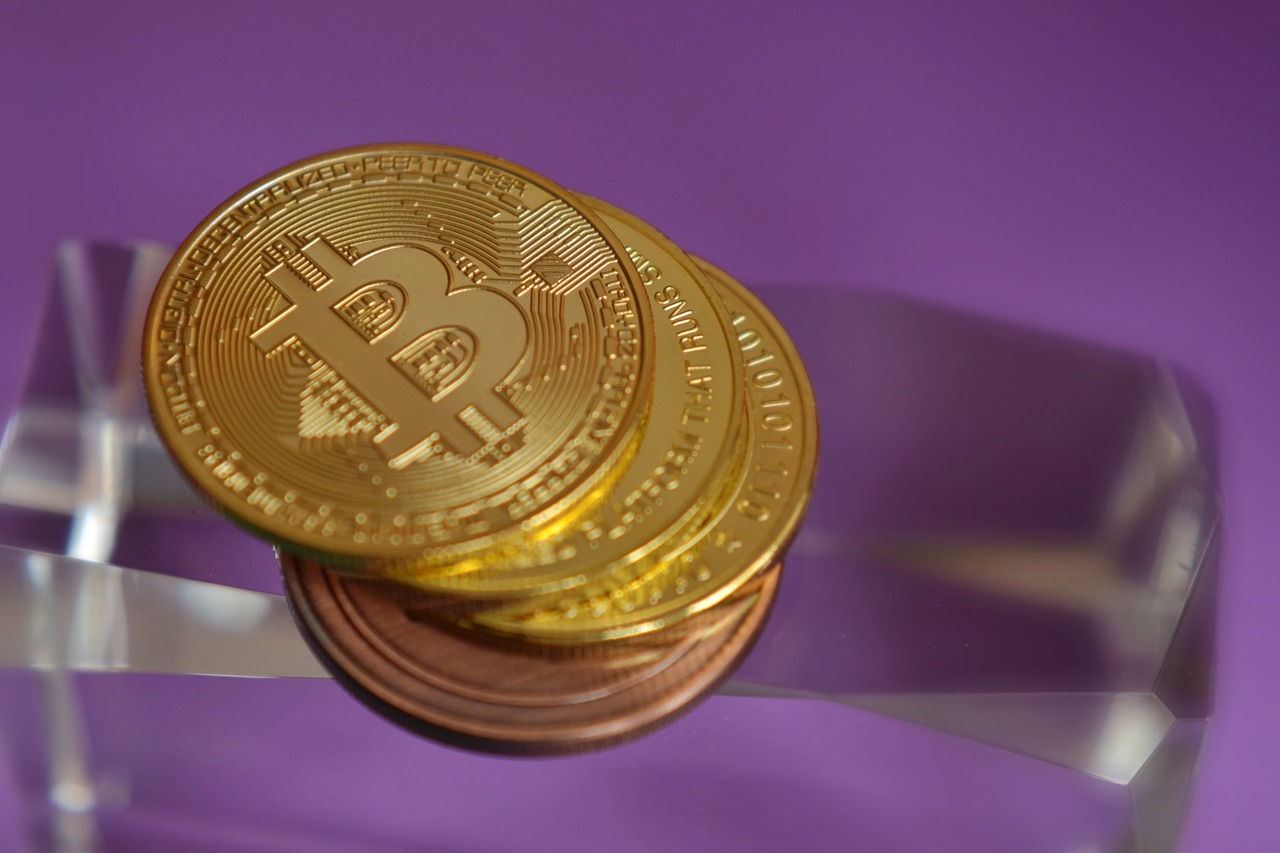
Challenges and Limitations
While Solana has made significant strides in the blockchain arena, it is not without its . One of the most pressing issues is the network outages that have occurred, raising concerns about its reliability. In the fast-paced world of cryptocurrency, even a brief downtime can lead to substantial losses for users and developers alike. Imagine trying to make a quick trade only to find that the network is down—frustrating, right?
Moreover, as Solana continues to grow, the security concerns surrounding its architecture become more pronounced. With its unique Proof of History (PoH) mechanism, while it offers impressive speed, it also presents potential vulnerabilities that could be exploited. Hackers are always on the lookout for weaknesses, and the more popular a blockchain becomes, the more it attracts unwanted attention. Solana must continuously innovate and fortify its security measures to safeguard its users' assets.
Another challenge is the competition from other blockchain platforms. Ethereum, Binance Smart Chain, and newer entrants like Avalanche and Polkadot are all vying for the same developer and user attention. Each platform has its unique features and advantages, making it crucial for Solana to not only maintain its performance metrics but also to differentiate itself in terms of community support, developer tools, and user experience. The blockchain space is akin to a bustling marketplace where only the most innovative and adaptable platforms thrive.
Additionally, the rapid growth of Solana has led to concerns about its decentralization. A blockchain's true strength lies in its decentralization, which ensures that no single entity has control over the network. As Solana attracts more users and projects, it risks becoming more centralized, especially if a few large players dominate the ecosystem. This centralization could undermine the foundational principles of blockchain technology, which is all about trust and transparency.
In summary, while Solana boasts remarkable speed and scalability, it must address these challenges to ensure its long-term success and sustainability. The blockchain landscape is ever-evolving, and only time will tell how Solana adapts to these hurdles.
- What are the main challenges Solana faces? Solana faces challenges such as network outages, security vulnerabilities, competition from other blockchains, and potential centralization issues.
- How does Solana's Proof of History work? Proof of History (PoH) creates a verifiable order of events to enhance the speed and security of transactions on the network.
- What makes Solana different from Ethereum? Solana offers higher transaction speeds and lower costs compared to Ethereum, making it more attractive for developers and users.
- Is Solana secure? While Solana has robust security measures, like any blockchain, it is not immune to vulnerabilities and must continuously evolve to combat threats.
Frequently Asked Questions
- What is Solana?
Solana is a high-performance blockchain platform designed for speed and scalability. It supports thousands of transactions per second, making it ideal for various applications, including decentralized finance (DeFi), non-fungible tokens (NFTs), and gaming.
- How does Solana achieve such high transaction speeds?
Solana utilizes a unique architecture that includes a Proof of History (PoH) consensus mechanism. This allows the network to create a verifiable order of events, significantly reducing the time needed for transaction confirmations.
- What are the key features of Proof of History?
Proof of History is a groundbreaking feature that timestamps transactions, enabling nodes to verify the order of events without extensive communication. This innovation helps maintain low latency and high throughput, setting Solana apart from other blockchains.
- How does Solana compare to Ethereum?
When comparing Solana to Ethereum, Solana generally offers faster transaction speeds and lower costs. However, Ethereum has a more established ecosystem and larger developer community, which can be beneficial for certain projects.
- What are some notable use cases for Solana?
Solana has attracted a variety of projects, particularly in the DeFi space, where its speed and low transaction fees are transforming how financial services operate. Additionally, it's gaining traction in the NFT market and gaming industry.
- Are there any challenges facing Solana?
Yes, while Solana boasts impressive speed and scalability, it faces challenges such as occasional network outages, security concerns, and competition from other blockchain platforms. Addressing these issues will be crucial for its continued growth.
- What is the future potential of Solana?
Given its innovative technology and growing ecosystem, Solana has significant potential for future growth. As more developers and users are attracted to its platform, we can expect to see new applications and projects emerging, further solidifying its position in the blockchain space.











